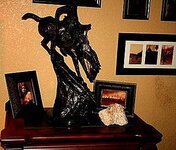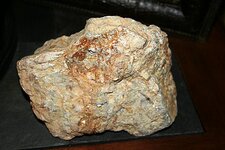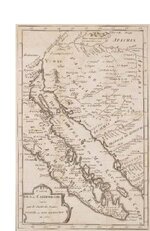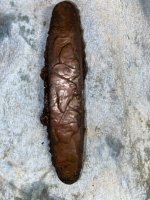Oroblanco
Gold Member
- Jan 21, 2005
- 7,838
- 9,830
- Detector(s) used
- Tesoro Lobo Supertraq, (95%) Garrett Scorpion (5%)
El Naranjal
, "the orangery" one of the most famous of all the lost mines of Old Mexico. Some would go so far as to say it was second only to Tayopa in fame and in number of seekers.
The name El Naranjal means "the orangery" and no one really knows the origins of the name; some say it was named that because the huge gold nuggets, from the mine, alloyed with silver, were the size and resemblance of oranges; others say it was because of the orange groves at the hacienda of the owner of the mine, from which oranges are said to still float down the river which flows past the ranch. The hacienda lies in ruins today, in one of those many narrow, tortuous barrancas of Sinaloa, along a trail so long lost and hidden that it would be quite a task even to find the trail. El Naranjal was supposed to be not too far from another famous old mine, known as Juana de Arco, "Joan of Arc".
The mine certainly did exist; an American prospector once found a road sign on a dim ancient trail, on which was a cross and some lettering. Wiping the stone, he was able to make out this:
|
___
|
Departemento
de
Caminos
Camino a Las Minas
de Arco
y
Naranjal
A British consul found records in Guadalajara that proved El Naranjal had produced millions in the seventeenth century. How the mine and the hacienda came to be lost, is due to the revolution against Spanish rule and the grandee propertied class in 1810. Those who have seen the hacienda say it still has groves of orange trees yet growing, though extremely old.
Where is El Naranjal? El Naranjal lies in one of those narrow barrancas, on the narrow valley floor near the hacienda. The location is said to be somewhere generally west of the point where the border line of the states of Durango and Sinaloa meet, in the country of the Tepehuane Indians.
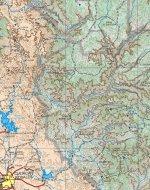
Perhaps you will be the lucky one who finds it!
Oroblanco
Other information, from various sources:
>>>>>>>>>>>>>>>>>>>>>>>>>>>>>>>>>>>>>>>>>>>>>>>>>>>>>>>>>>>>>>>>>>>>>>>>>>>>>>>>>>>>>>>>
The Lost El Naranjal, a mine with a gigantic pile of rich gold ore dug from it and stockpiled inside is located in the area of El Naranjo, east of Los Mochis and about 100 miles southwest of the Seven Cities ruins site in the vicinity of the small stream named Evera Mocorito. The ancient diggings are on a high mesa in the shadow of a towering mountain.
>>>>>>>>>>>>>>>>>>>>>>>>>>>>>>>>>>>>>>>>>>>>>>>>>>>>>>>>>>>>>>>>>>>>>>>>>>>>>>>>>>>>
Many are the exploring parties, equipped by wealthy mine owners, that have gone in search of " El Naranjal ": many the supposed clues, such as traces of gold in a mountain stream, or a piece of rich quartz on the trail, that have been followed for weeks, only to end in disappointment. " El Naranjal," to all intents and purposes, existed only in the imagination of the people, who still talked about it as confidently as though it were an established fact. Their stories always held a peculiar fascination for me. It was not so much the hidden treasure as the old hacienda itself that excited my imagination. I often pictured the ruined buildings and the deserted chapel, whose bell had been silent for a century, save for a muffled note perhaps that fell from it on stormy nights; with no sign of life save the bats that flitted in and out at nightfall, and with the orange trees growing thicker and taller, shutting it more and more away from the world.
So one day when a man said to me, " I have seen ` El Naranjal,' I stared at him in amazement for fully a minute, before I could believe my senses. Then I passed him my pocket flask, offered him a cigarro and waited for him to continue. He was a character, such as you will find only in a mining camp: half-Mexicanized, through long residence in the country; always threatening to leave it, yet never leaving; always expecting to strike it rich and never striking it.
" Yes," he went on, "I have seen ` El Naranjal.' It happened this way. I had been prospecting all summer near an old pueblo north of Durango, and was returning to the city for the holidays. The first night out, I came to a lone Indian rancho about sundown, and asked if I could sleep there. The owner, an old white-haired fellow, lived alone and as the road was seldom traveled, he seemed rather glad to see me. I had with me a couple of flasks of Scotch whisky, and when we had made a supper on beans and tortillas, I got out one of the bottles and after a number of pulls, he became exceedingly friendly. The talk turned on old mines, and he finally told me that he knew where there was a very rich one, with a ruined hacienda.
" He said it was during a war, probably the French intervention, and that the government had sent soldiers into the mountains after recruits. He took what cattle he had and drove them over the mountains and down the other side. At the bottom of the canon beyond, which he had reached by following an old trail, he came on an abandoned hacienda. The mine, which was close by, had been worked extensively; and he picked up a piece of rock on the dump, with chunks of pure gold, as yellow as the oranges. I questioned him more closely. He said there were many orange trees and that they were very old; and then I felt satisfied he had seen the lost Naranjal. I asked him if he would take me there; but he replied evasively and became very reticent, so the subject dropped.
" The next morning I waited anxiously for him to refer to it again, but he said never a word; and my experience with Indians had taught me never to try forcing their hand. The old fellow had treated me well, and as I was about to leave, I gave him the flask, which still had a little whisky left. His eyes glistened with delight and he went and put it carefully inside an ancient chest made of rawhide, that stood in the corner. Re-turning he handed me, without speaking, a piece of rock. Instinctively I knew it was the one he had picked up on the ore-dump: I held it to the light and saw gold nuggets, as big as the end of my little finger.
" I looked at the old man and waited for him to speak. Instead he took my arm and led me into the corral. Pointing to the mountains, he asked if I saw a peak that looked like a big piloncillo (conical loaf of sugar). On my answering in the affirmative, he said the trail he had followed crossed at that point. He was silent for a while as though thinking deeply. At last he said that if I wanted to see the old mine he would go with me as far as the peak, and start me on the right trail. Beyond that point, he himself would not go. He said there were bears and tigers on the other side, and that I would need to go well armed and with provisions for a week or more.
" Impressed as I was by what he had told me, I was in no position to profit by it. I was alone, with no chance of getting aid inside of five days and without sufficient money to secure an outfit in any event. I determined, however, to remember the peak and that some day I would return and look for the mine. I cautioned the old man not to mention it to any one else. He looked at me gravely and replied that he was a youth at the time he made the discovery, and that I was the first one he had ever told. Promising him I would return, I set out for Durango.
" When I arrived, I learned that the men I had been working for had lost faith in the prospect and did not need my services any longer. I tried in vain to interest several mining men in ` El Naranjal.' They all heard me through, but had invariably too many irons in the fire already, to start on such a wild-goose chase, as they termed it; and I was at last compelled to go to work from actual necessity. Years went by and while I never forgot the old Indian's story I could never quite see my way clear to follow it up. Yes, I am a drinking man, a heavy one at times, like nearly all the old stagers; and often the money went in a spree that might have helped me to ` El Naranjal' and a fortune. It got so finally, that when I told the story people only laughed. I regretted a hundred times that I had not gotten possession of the rock, by hook or crook. The old man seemed loth to part with it, and at the time I did n't stop to consider the importance of having it to show.
" It was ten years later, when at last I saw my chance. I had been prospecting for some rich Americans at a point that I believed to be within at most four days' ride of the Indian's rancho. I was working some twenty odd peones and had been left in full control. The prospect looked more and more dubious and I had no mind to continue. Neither had I a mind to throw up the sponge. The story of the lost `Naranjal' haunted me. I thought of it by day and at last one night, in a dream, I saw as plain as I see you, the old hacienda with the orange trees growing all about it. The next day I picked out four of my best men, took what money I had on hand and prepared to hit the trail. Of course I did wrong to go without consulting my employers, but I had `El Naranjal' on the brain. Besides I felt sure of success. After we had fairly started, I began to feel anxious about my old Indian. Was he living after all these years? I wondered.
" The journey proved longer than I had figured on, but the night of the fifth day, just as I was wondering if I could have missed the trail, I saw the familiar rancho. I went to the door with a beating heart and was met by a middle-aged man, whom I saw at once was too young to be my former friend. He proved to be his brother, and said the aged Indian had been dead several years, though he could not tell how many. I spent the night at the rancho and in course of conversation touched on old mines, but he professed the densest ignorance regarding them. At last I asked him point blank if his brother had never told him of his discovery, adding that he had not only told me of it, but offered to direct me to the place. For a second he eyed me suspiciously. Then going to the old chest, which I re-membered only too well he took from it a small, black flask and holding it up before me, asked if it was mine. For a moment I was puzzled. Then like a flash it came to me, that I had given the old Indian what little liquor it contained on leaving him. I answered that it had once been mine, but that I had given it to his brother. At that he became voluble for an Indian. He said his brother had always looked for my return and had talked of me to the last, instructing him, in case I did come, to go with me to the peak of the mountain, and show me the old trail. I was wild to be off and finally persuaded him to start with us the next morning.
" It was near sunset the next day when we reached the cone-shaped peak, and the old man got off his mule and began scanning the slope on the other side. At length he gave a satisfied grunt and holding aside the tall grass, pointed to the faint semblance of a trail. I was to follow that trail two or three days, he said, and I should see the hacienda. He then put out his hand. Greatly surprised, I pressed him to pass the night with us; but he steadfastly refused, and with one backward glance, that had in it something of dread, in the direction of the abandoned trail, he bade me ` Godspeed' and disappeared in the darkness. I was too excited to sleep and finally got up and sat by the fire till day-break. We started as soon as it was light and then began one of the hardest jobs I had ever undertaken. It is not always a simple matter to keep on a trail that is in constant use; and when it comes to one that has not been used for half a century or more it is next to impossible. Sometimes we lost it and were an hour beating about in the brush, before we found it again. We had to walk, as the animals were as much at sea as we were; and we frequently had to cut our way through dense growths of chaparral. Sunset found us on a bare ledge of rocks, where the trail disappeared, and there was nothing to do but camp there for the night.
" At daybreak we began hunting for the trail, and the men had declared repeatedly there was an end of it when I discovered it, doubling on itself and leading through the brush again. I sent two men ahead with machetes to make a path, and we followed slowly, leading the animals. Night found us apparently no nearer our goal. We were still descending the mountain, and on every hand stretched the limitless chaparral. I have been in lonely places, but never one like that. The old man had talked of bears and tigers. There was absolutely not a sign of life, not even a bird save an occasional vulture, sailing overhead. The men looked downcast and after supper one of them came and asked me to turn back. He said his companions were all triste (sad) and `afraid we were going to the death.' I asked him why they thought so and he replied be-cause the vultures had followed us for two days. For answer I told him to make ready for an early start and assured him we should make it in one day more. Then I rolled myself in my blankets.
" When I woke it was not yet light, but before I had actually opened my eyes, I knew I was alone. I called out but there was no reply. The cowards, satisfied that I would not turn back, had deserted me in the night; and when daylight came, I found they had taken the best part of the provisions. I cursed them till I was tired out, and swore with every oath that I would never give up till I had seen the mine, and that if I failed, the vultures were welcome to my carcass. Then I started again, hewing my way with a machete, that had luckily been left behind. I kept on all day, not even stopping to eat and had about decided to give it up until the following morning, when I suddenly came to a part of the slope that seemed a wide ledge of red sandstone. It was devoid of vegetation and the trail was sharply de-fined, being worn deep in the sandy formation. I determined to push on, relying on my mule to keep on the trail.
It was now so dark I could not see four feet ahead. My mule seemed nervous and several times stood stock-still. I got off repeatedly and groped about in the darkness, to make sure I was still on the trail. I had just gotten into the saddle and ridden perhaps five rods further, when she came to a sudden standstill, snorted and began to tremble. I urged her forward but she reared and tried to bolt up the mountain. I turned her about and forced her on a few steps, when she stopped again and showed every sign of extreme terror. Dismounting I took a step forward, retaining my hold on her neck and it was well I did, for I found myself stepping into space, and only saved myself by hanging on to the mule. I had used my last match and there was nothing to do but stay my hunger as best I could and wait for daylight. It was evident that I had reached some sort of a jumping-off place; how much of a one I should know in the morning.
When I awoke the sun was high. I had slept from sheer exhaustion, but I was provoked at finding it broad daylight. It was fortunate for me that it was though, for as I sprang up and started forward, I saw that I was near the edge of a precipice; and the thought of my close shave made me feel hot and cold by turns. I crept nearer and saw that the trail ran to the very edge of the cliff, which had the appearance of a mountain that had been sliced off like a loaf of bread. Crawling to the edge, I looked over and saw a perpendicular descent of thousands of feet, which, instead of sloping outward at the base, receded; and at either side, as far as I could see, was the same precipitous wall. The bottom of the canon was four thousand feet below. As I scanned it hurriedly, a shining line of silver caught my eye — a river of course—and there, close beside it, was a clump of bright green foliage, with patches of white that could be nothing less than the walls of the hacienda. Yes there was ` El Naranjal,' I could have sworn it: yet no desert mirage was ever more inaccessible. On every hand towered those forbidding cliffs. My provisions were exhausted. My mule was ready to drop in her tracks. I knew that unless I turned back and made the rancho, I should starve to death; on looking up I saw the vultures still sailing overhead. I sat for hours, gazing at that patch of green, till I could almost see the outlines of the buildings. Once I thought I heard the chime of a bell. At last, aroused by the burning sun, I took one last look and started sadly up the mountain, dragging my mule after me. Even then I was not satisfied to go, but turned again and again, till I could no longer see the bottom of the canon.
" Before night, my mule lay down and refused to stir. I took off the saddle and left her. After that I lost sight of the vultures. Weary as I was, the ascent was much quicker than going the other way and after three days of terrible suffering, I reached the rancho, only to find it deserted. I managed to get into the house where I found a little corn. That night I chewed corn and drank water. The next day I made tortillas and then set out for Durango. Falling in with some freighters, I gladly traveled with them, and part of the way had a mule to ride. When I reached the city, I wrote a full account of my experience to my employers. I had some doubt as to whether they would believe me, and while waiting for an answer, my old enemy got the best of me and I went on a spree. It ended in an attack of fever and when I came to my senses two letters were handed me. The first one requested me to come at once; the second said they had heard of my goings on and that they washed their hands of me. I told my story again and again, but no one took any stock in it and so for the second time, I was obliged to give the thing up. I shall have one more try at it though: I am waiting for a man now who has promised me an outfit, and you may be sure there will be plenty of rope to get down over those cliffs with. I'm going to find `El Naranjal' or die trying. Who knows ! You may see me on Easy Street yet!"
This is the story of the man who says he has seen "El Naranjal." Will he yet reach it and "Easy Street "? Who knows? Meantime the ancient hacienda sleeps peacefully among the orange trees, and the golden nuggets, yellow as the shining fruit, lie hidden away in the dark chambers of the old mine.



 Maybe, if I can get the time and money.......! 8) This mine was a real producer, would be a real find.
Maybe, if I can get the time and money.......! 8) This mine was a real producer, would be a real find.
